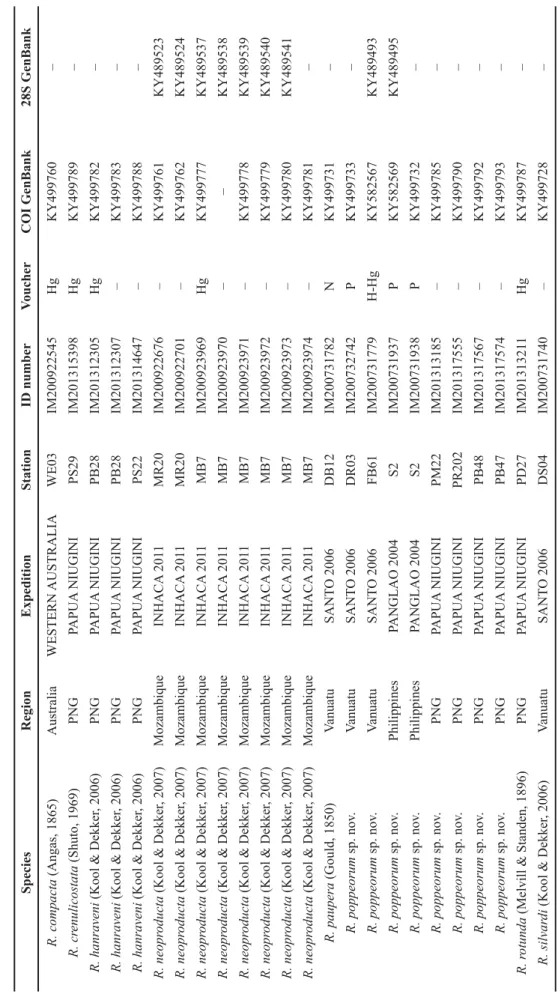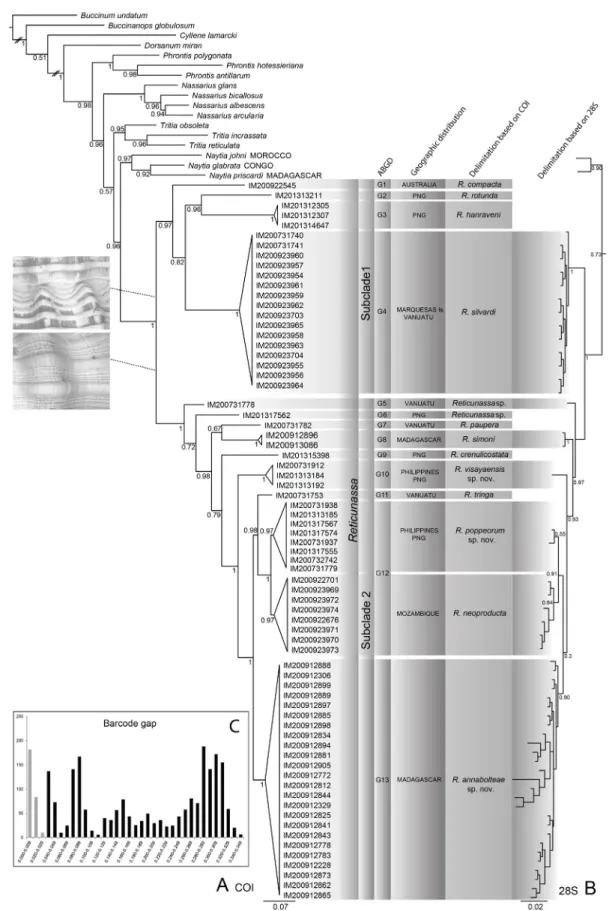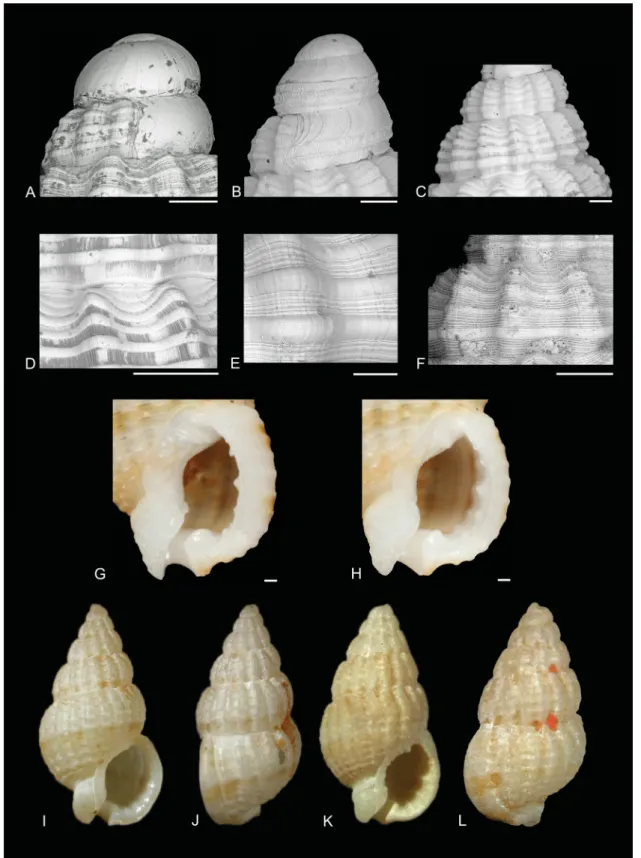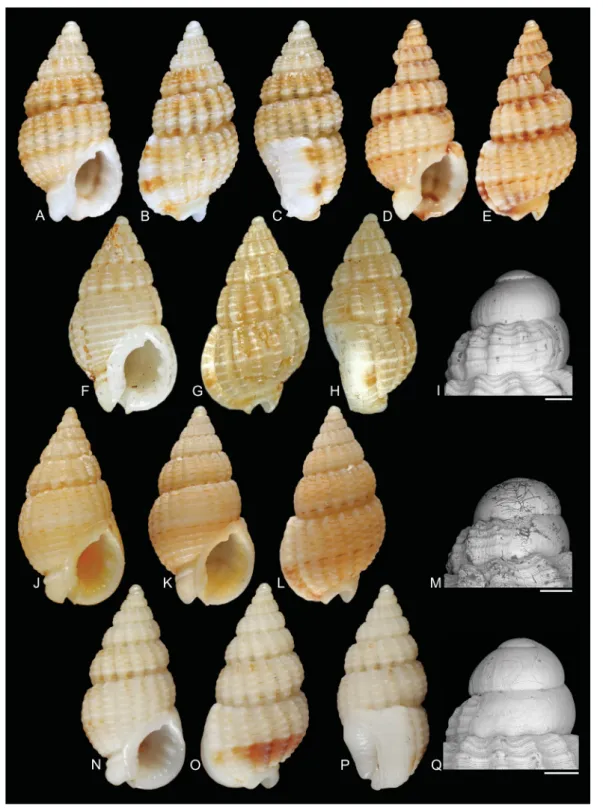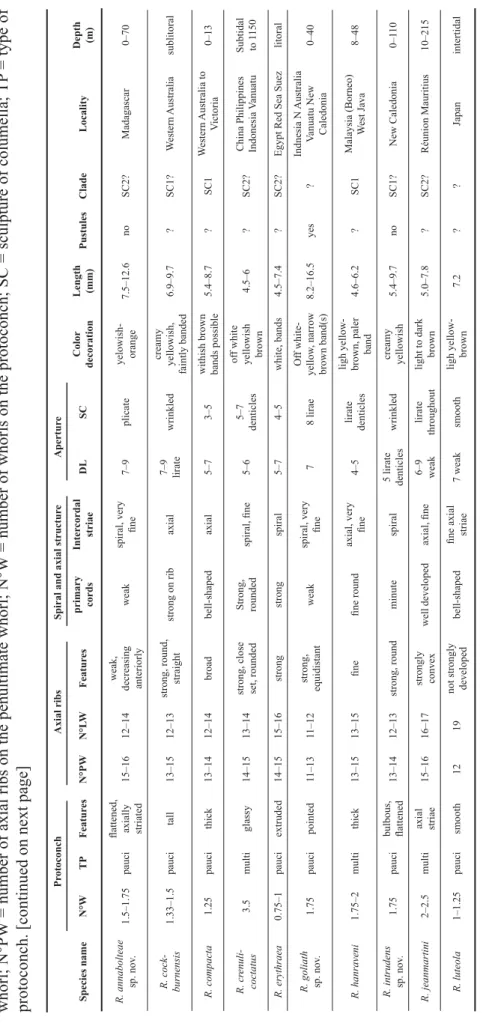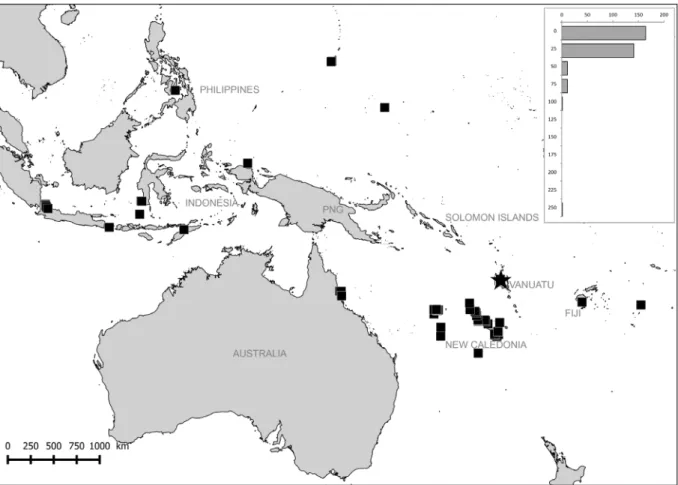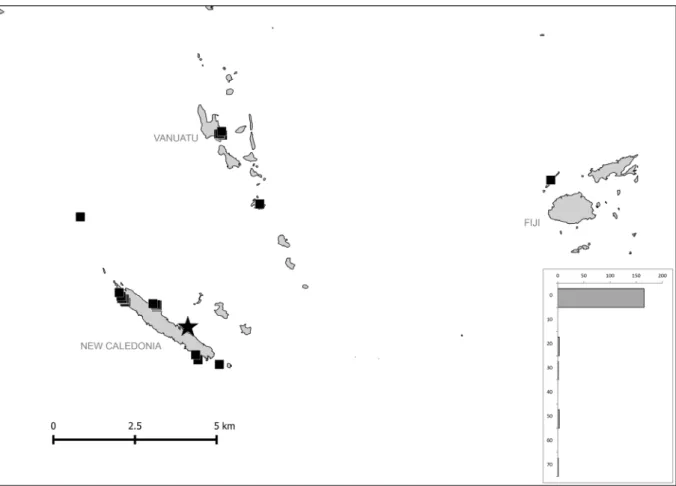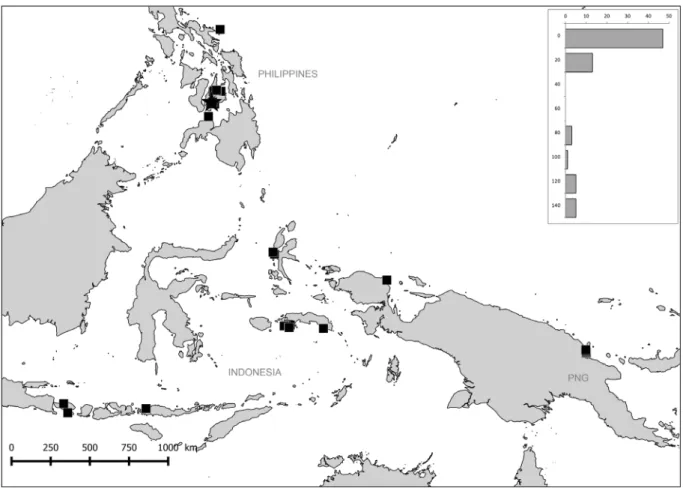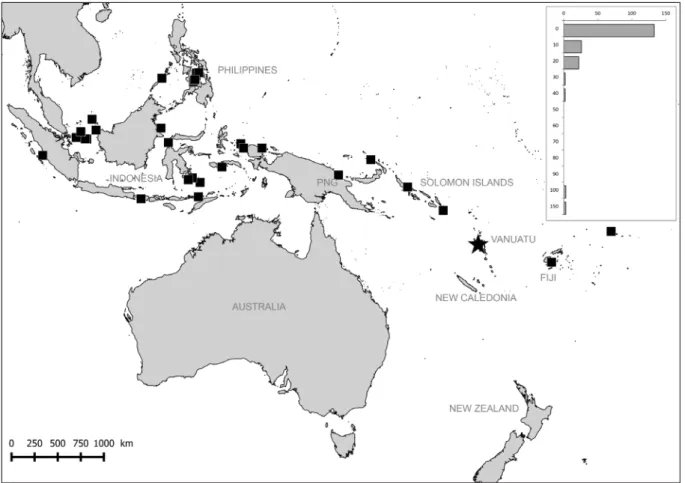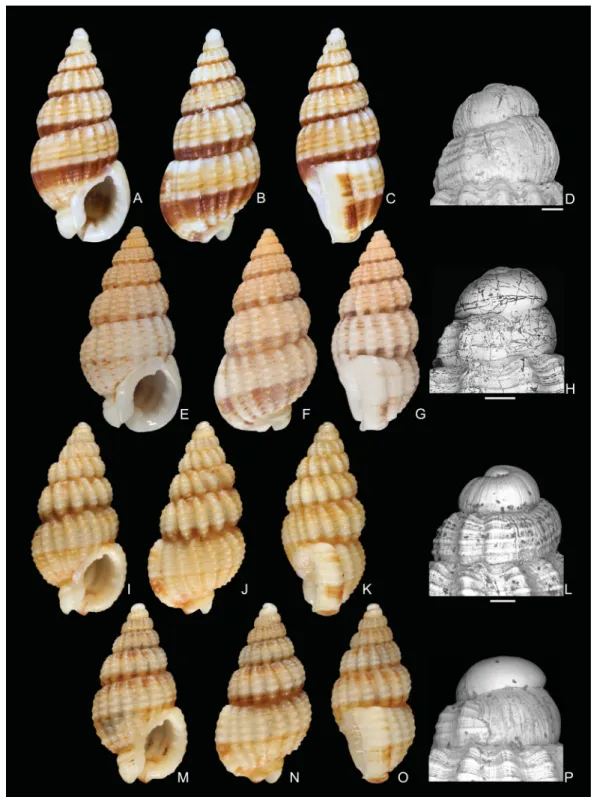http://dx.doi.org/10.5852/ejt.2017.275 www.europeanjournaloftaxonomy.eu 2017 · Galindo L.A. et al.
This work is licensed under a Creative Commons Attribution 3.0 License.
D N A L i b r a r y o f L i f e , r e s e a r c h a r t i c l e
urn:lsid:zoobank.org:pub:FC663FAD-BCCB-4423-8952-87E93B14DEEA
Review of the Nassarius pauperus (Gould, 1850) complex (Nassariidae): Part 3, reinstatement of the genus Reticunassa,
with the description of six new species
Lee Ann GALINDO 1*, Hugo H. KOOL 2 & Henk DEKKER 3
1 Muséum national d’Histoire naturelle, Département Systématique et Evolution, ISyEB Institut (UMR 7205 CNRS/UPMC/MNHN/EPHE), 43, Rue Cuvier, 75231 Paris, France.
2,3 Associate Mollusca Collection, Naturalis Biodiversity Center, P.O. Box 9517, 2300 RA Leiden, the Netherlands.
* Corresponding author: galindo@mnhn.fr
2 Email: hugo.kool@naturalis.nl
3 Email: h-dekker@quicknet.nl
1 urn:lsid:zoobank.org:author:B84DC387-F1A5-4FE4-80F2-5C93E41CEC15
2urn:lsid:zoobank.org:author:5E718E5A-85C8-404C-84DC-6E53FD1D61D6
3 urn:lsid:zoobank.org:author:DA6A1E69-F70A-42CC-A702-FE0EC80D77FA
Abstract. In this review (third part), several species within the Nassarius pauperus complex from the eastern Indian Ocean and western Pacifi c are treated, including a revised concept of Nassa paupera Gould, 1850, type species of the genus Reticunassa Iredale, 1936. In the most recent taxonomic revision, several species had been synonymized with Nassarius pauperus (Gould, 1850), despite distinctive differences among these species in shell morphology. We sequenced a fragment of the mitochondrial COI and the nuclear 28S genes of all available Nassarius pauperus complex species. Automatic barcode gap discovery and reciprocal monophyly were applied to propose species delimitation hypotheses and to support a new concept of the genus. Using morphological and molecular characters, Reticunassa is elevated to full genus rank. Six new species are described: Reticunassa visayaensis sp. nov., R. poppeorum sp. nov., R. annabolteae sp. nov., R. goliath sp. nov., R. intrudens sp. nov. and R. thailandensis sp. nov., while R. tringa (Souverbie, 1864) is recognized as a valid species.
Keywords. Nassarius pauperus complex, taxonomy, species delimitation, neotype, barcoding.
Galindo L.A., Kool H.H. & Dekker H. 2017. Review of the Nassarius pauperus (Gould, 1850) complex (Nassariidae). Part 3, reinstatement of the genus Reticunassa, with the description of six new species. European Journal of Taxonomy 275: 1–43. http://dx.doi.org/10.5852/ejt.2017.275
Introduction
In his systematic revision of the species of Nassariidae, Cernohorsky (1984) treated 16 taxa as junior synonyms of Nassarius (Hinia) pauperus (Gould, 1850) (as “Hima”). All these nassariids are rather
similar and the small morphological differences were interpreted by Cernohorsky (1984) as representing intraspecifi c variation. Kool & Dekker (2006, 2007) discussed, in parts 1 and 2 of this ongoing review, whether many of these synonyms should not be considered valid species. DNA data obtained from live specimens collected during several MNHN expeditions were used here as evidence to support species hypotheses originally based solely on morphological features.
Kool & Dekker (2006, 2007) defi ned some informative morphological characters for the species included in the Nassarius pauperus complex (often as “pauper-complex”). Among these characters are the type and sculpture of the protoconch, the morphology of the spiral cords, the sculpture on the surface between the spiral cords, and the shape and sculpture of the columellar callus. Using molecular characters, Galindo et al. (2016) demonstrated that species attributed to the Nassarius pauperus complex clustered together in a clade separate from the genus Nassarius Duméril, 1805 s. str.
In part 1 of the Nassarius pauperus complex review, Kool & Dekker (2006) described six species with intercordal axial sculpture. In part 2, Kool & Dekker (2007) treated four species with intercordal spiral sculpture, from the western Indian Ocean to the central Pacifi c Ocean. In this third review, we treat eight species (of which six are new to science) from the eastern Indian Ocean and the Western Pacifi c, all with intercordal spiral sculpture. The new taxonomic scheme is supported by a species tree based on molecular data.
On the basis of the molecular analysis presented here, Reticunassa Iredale, 1936 is elevated to full genus status to include the species formally considered as constituting the Nassarius pauperus complex.
Material and methods
Material was obtained from various natural history museums and private collections, listed in the acronyms section. Live-collected specimens used for molecular studies were anesthetized with MgCl2 or microwaved (see Galindo et al. 2014). The bodies, preserved in 95% ethanol, were removed from the shells in the laboratory to prevent progressive deterioration of the shells by etching. The shells are kept dry and have been assigned the same registration number as the corresponding body or tissue in ethanol.
A stereo microscope was used to observe shell morphology and color patterns. A digital caliper (accurate to 0.1 mm) was used for measurements. Shells of the new species were photographed in dorsal, ventral and lateral views, using a Canon EOS 60D camera. Scanning electron microscope (SEM) images were obtained by backscattered electron diffraction on a VEGA II LSU TESCAN, under conventional high vacuum at 20 kV acceleration voltage (12 to 15 Pa chamber pressure) at the SEM-EDS of the ‘Direction des Collections’ at MNHN. In general, the terms and methods used for the morphological analysis follow part 1 of the review (Kool & Dekker 2006).
Acronyms
ABGD = Automatic Barcode Gap Discovery
AMD = Aart M. Dekkers, Blokker, the Netherlands BOLD = Barcode of Life Database
CP = beam trawl DW = Warén dredge
GH = Glad M. Hansen, Lathlain, Australia HD = Henk Dekker, Winkel, the Netherlands HK = Hugo H. Kool, Dieren, the Netherlands HUJ = Hebrew University, Jerusalem, Israel
JGMR = J.G.M. (Han) Raven, the Hague, the Netherlands
MCZ = Museum of Comparative Zoology, Harvard University, Cambridge, MA, USA NHMUK = The Natural History Museum, London, United Kingdom
MHNBx = Muséum d’Histoire naturelle, Bordeaux, France MNHN = Muséum national d’Histoire naturelle, Paris, France MUZEE = Muzee Scheveningen, Scheveningen, the Netherlands NBC = Naturalis Biodiversity Center, Leiden, the Netherlands PS = P. Stahlschmidt, Rohrbach, Germany
RMNH = Rijksmuseum voor Natuurlijke Historie, collection incorporated in NBC
USNM = United States National Museum, Smithsonian Institution, Washington DC, USA ZMA = Zoölogisch Museum Amsterdam, collection incorporated in NBC
Abbreviations l = length
lv = live-collected specimen
spm = specimen(s), in Material examined sections stn = station
w = width
Molecular sequencing was carried out at the Service de Systématique Moléculaire (MNHN UMS 2700).
Procedures from the Consortium for the Barcode of Life barcoding protocols (www.barcodeofl ife.org) adapted to large biodiversity collections were followed (see Puillandre et al. 2012a). A piece of muscle from the foot, suffi cient for approximately fi ve DNA extractions, was stored in a 2D barcode tube as a reference tissue collection. Extraction was done with the NucleoSpin® 96 Tissue Core Kit adapted to a NucleoSpin® 96 Plasmid Binding Plate (Macherey-Nagel) using a liquid handling workstation (epMotion® 5075 VAC, Eppendorf). Purifi ed DNA was stored in a second 2D tube. PCR reactions were performed in 20 μl, containing 2 μl of DNA, 1× reaction buffer, 2.5 mM MgCl2, 0.26 mM dNTP, 0.3 μM of each primer, 1 μl DMSO, 1 μl BSA (10 mg/l) and 1.5 units of Q-Bio Taq DNA polymerase (QBiogene, Carlsbad, California, USA). A fragment of 658 bp of the cytochrome oxidase I (COI) mitochondrial gene was amplifi ed, using the universal primer set (LCO1490 and HCO2198) (Folmer et al. 1994) and a primer set specifi c for Nassariidae (5COIF: 5’ACAAATCATAAAGAYATTGGAAC-3’, 492COIR:
5’CGCTCAAATTGTATTCCTCG-3’ and 492COIRD: 5’CGYTCRAATTGTATYCCTCG-3’) (Galindo et al. 2016). Annealing temperature was 50°C for 35 seconds. The fi rst subunit of the 28S gene was amplifi ed using the C1’ and D2 primers of Chisholm et al. (2001). Annealing temperature was 58ºC for 40 seconds or a touchdown gradient from 66ºC to 56ºC for 8 seconds (plus 58ºC for 30 seconds) whenever double bands were present. Sequencing was carried out by the Centre National de Séquençage, Genoscope (Évry, France) and Eurofi ns Genomics (Paris, France). In all cases, both directions were sequenced to confi rm the accuracy of each haplotype.
Sequence cleaning and alignment was done by using Codon Code Aligner software. GenBank accession numbers for all the sequences obtained are included in Table 1. We compiled a dataset of sequences available for several closely related species, identifi ed in a phylogenetic tree, based on a large dataset of Nassariidae (Galindo et al. 2016) to compare with our new species hypotheses. The analysis involved 89 COI sequences: 72 of them belong to the Nassarius pauperus complex, 16 sequences to other species of Nassariidae and one to a distant outgroup. The Automatic Barcode Gap Discovery (ABGD) method using the default parameters (Puillandre et al. 2012b) was employed. It automatically detects, when present, a threshold (the barcode gap) in the pairwise distribution of the genetic distances calculated between each pair of specimens.
To test whether the species hypotheses proposed by ABGD corresponded to monophyletic groups, Bayesian analyses, consisting of two Markov chains (35 million generations each with a sampling
Table 1. GenBank accession numbers for sequenced specimens of Reticunassa included in this paper. H = holotype; Hg = hologenophore; N = neotype; P = paratype; PNG = Papua New Guinea. [continued on next two pages] SpeciesRegionExpeditionStationID numberVoucherCOI GenBank28S GenBank R. compacta (Angas, 1865)AustraliaWESTERN AUSTRALIAWE03IM200922545HgKY499760– R. crenulicostata (Shuto, 1969)PNGPAPUA NIUGINIPS29IM201315398HgKY499789– R. hanraveni (Kool & Dekker, 2006)PNGPAPUA NIUGINIPB28IM201312305HgKY499782– R. hanraveni (Kool & Dekker, 2006)PNGPAPUA NIUGINIPB28IM201312307–KY499783– R. hanraveni (Kool & Dekker, 2006)PNGPAPUA NIUGINIPS22IM201314647–KY499788– R. neoproducta (Kool & Dekker, 2007)MozambiqueINHACA 2011MR20IM200922676–KY499761KY489523 R. neoproducta (Kool & Dekker, 2007)MozambiqueINHACA 2011MR20IM200922701–KY499762KY489524 R. neoproducta (Kool & Dekker, 2007)MozambiqueINHACA 2011MB7IM200923969HgKY499777KY489537 R. neoproducta (Kool & Dekker, 2007)MozambiqueINHACA 2011MB7IM200923970––KY489538 R. neoproducta (Kool & Dekker, 2007)MozambiqueINHACA 2011MB7IM200923971–KY499778KY489539 R. neoproducta (Kool & Dekker, 2007)MozambiqueINHACA 2011MB7IM200923972–KY499779KY489540 R. neoproducta (Kool & Dekker, 2007)MozambiqueINHACA 2011MB7IM200923973–KY499780KY489541 R. neoproducta (Kool & Dekker, 2007)MozambiqueINHACA 2011MB7IM200923974–KY499781– R. paupera (Gould, 1850)VanuatuSANTO 2006DB12IM200731782NKY499731– R. poppeorum sp. nov.VanuatuSANTO 2006DR03IM200732742PKY499733– R. poppeorum sp. nov.VanuatuSANTO 2006FB61IM200731779H-HgKY582567KY489493 R. poppeorum sp. nov.PhilippinesPANGLAO 2004S2IM200731937PKY582569KY489495 R. poppeorum sp. nov.PhilippinesPANGLAO 2004S2IM200731938PKY499732– R. poppeorum sp. nov.PNGPAPUA NIUGINIPM22IM201313185–KY499785– R. poppeorum sp. nov.PNGPAPUA NIUGINIPR202IM201317555–KY499790– R. poppeorum sp. nov.PNGPAPUA NIUGINIPB48IM201317567–KY499792– R. poppeorum sp. nov.PNGPAPUA NIUGINIPB47IM201317574–KY499793– R. rotunda (Melvill & Standen, 1896)PNGPAPUA NIUGINIPD27IM201313211HgKY499787– R. silvardi (Kool & Dekker, 2006)VanuatuSANTO 2006DS04IM200731740–KY499728–
SpeciesRegionExpeditionStationID numberVoucherCOI GenBank28S GenBank R. silvardi (Kool & Dekker, 2006)VanuatuSANTO 2006DS04IM200731741–KY499729KY489491 R. silvardi (Kool & Dekker, 2006)Marquesas I.PAKAIHI I TE MOANA-IM200923703–KY499763– R. silvardi (Kool & Dekker, 2006)Marquesas I.PAKAIHI I TE MOANAMQ13-GRIM200923704–KY499764– R. silvardi (Kool & Dekker, 2006)Marquesas I.PAKAIHI I TE MOANAMQ13-GRIM200923954–KY499765KY489525 R. silvardi (Kool & Dekker, 2006)Marquesas I.PAKAIHI I TE MOANAMQ13-GRIM200923955HgKY499766KY489526 R. silvardi (Kool & Dekker, 2006)Marquesas I.PAKAIHI I TE MOANA-IM200923956–KY499767KY489527 R. silvardi (Kool & Dekker, 2006)Marquesas I.PAKAIHI I TE MOANA-IM200923957–KY499768KY489528 R. silvardi (Kool & Dekker, 2006)Marquesas I.PAKAIHI I TE MOANA-IM200923958–KY499769KY489529 R. silvardi (Kool & Dekker, 2006)Marquesas I.PAKAIHI I TE MOANA-IM200923959–KY499770KY489530 R. silvardi (Kool & Dekker, 2006)Marquesas I.PAKAIHI I TE MOANA-IM200923960–KY499771KY489531 R. silvardi (Kool & Dekker, 2006)Marquesas I.PAKAIHI I TE MOANA-IM200923961–KY499772KY489532 R. silvardi (Kool & Dekker, 2006)Marquesas I.PAKAIHI I TE MOANAMQ13-GRIM200923962–KY499773KY489533 R. silvardi (Kool & Dekker, 2006)Marquesas I.PAKAIHI I TE MOANAMQ13-GRIM200923963–KY499774KY489534 R. silvardi (Kool & Dekker, 2006)Marquesas I.PAKAIHI I TE MOANAMQ13-GRIM200923964–KY499775KY489535 R. silvardi (Kool & Dekker, 2006)Marquesas I.PAKAIHI I TE MOANA-IM200923965–KY499776KY489536 R. simoni (Kool & Dekker, 2007)MadagascarATIMO VATAETS17IM200912896HgKY499754KY489517 R. simoni (Kool & Dekker, 2007)MadagascarATIMO VATAETS04IM200913086–KY499759KY489522 Reticunassa sp.VanuatuSANTO 2006FB61IM200731778HgKY499730KY489492 Reticunassa sp.PNGPAPUA NIUGINIPS45IM201317562HgKY499791– R. annabolteae sp. nov.MadagascarATIMO VATAEBM09IM200912228–KY499734– R. annabolteae sp. nov.MadagascarATIMO VATAETM05IM200912306–KY499735– R. annabolteae sp. nov.MadagascarATIMO VATAEBS14IM200912329–KY499736KY489496 R. annabolteae sp. nov.MadagascarATIMO VATAEBM02IM200912772–KY499737KY489497 R. annabolteae sp. nov.MadagascarATIMO VATAEBM06IM200912778–KY499738KY489498 R. annabolteae sp. nov.MadagascarATIMO VATAEBM06IM200912783–KY499739KY489499 R. annabolteae sp. nov.MadagascarATIMO VATAEBM06IM200912812PKY499740KY489500
SpeciesRegionExpeditionStationID numberVoucherCOI GenBank28S GenBank R. annabolteae sp. nov.MadagascarATIMO VATAEBM06IM200912825–KY499741KY489501 R. annabolteae sp. nov.MadagascarATIMO VATAETS09IM200912834–KY499742KY489502 R. annabolteae sp. nov.MadagascarATIMO VATAEBM06IM200912841–KY499743KY489503 R. annabolteae sp. nov.MadagascarATIMO VATAEBM06IM200912843HKY499744KY489504 R. annabolteae sp. nov.MadagascarATIMO VATAEBM06IM200912844–KY499745KY489505 R. annabolteae sp. nov.MadagascarATIMO VATAEBM06IM200912849P–KY489506 R. annabolteae sp. nov.MadagascarATIMO VATAEBM06IM200912855––KY489507 R. annabolteae sp. nov.MadagascarATIMO VATAEBM06IM200912862PKY499746KY489508 R. annabolteae sp. nov.MadagascarATIMO VATAEBB03IM200912865–KY499747KY489509 R. annabolteae sp. nov.MadagascarATIMO VATAEBM06IM200912868P–KY582570 R. annabolteae sp. nov.MadagascarATIMO VATAEBM10IM200912873–KY499748KY489510 R. annabolteae sp. nov.MadagascarATIMO VATAETS09IM200912881–KY499749KY489511 R. annabolteae sp. nov.MadagascarATIMO VATAETV07IM200912885–KY499750KY489512 R. annabolteae sp. nov.MadagascarATIMO VATAETM05IM200912888–KY499751KY489513 R. annabolteae sp. nov.MadagascarATIMO VATAETM05IM200912889–KY499752KY489514 R. annabolteae sp. nov.MadagascarATIMO VATAECP3547IM200912893––KY489515 R. annabolteae sp. nov.MadagascarATIMO VATAETM08IM200912894–KY499753KY489516 R. annabolteae sp. nov.MadagascarATIMO VATAETM05IM200912897–KY499755KY489518 R. annabolteae sp. nov.MadagascarATIMO VATAETV07IM200912898–KY499756KY489519 R. annabolteae sp. nov.MadagascarATIMO VATAETM05IM200912899–KY499757KY489520 R. annabolteae sp. nov..MadagascarATIMO VATAETM05IM200912905–KY499758KY489521 R. annabolteae sp. nov.MadagascarATIMO VATAETM05IM200913087––KY582571 R. tringa (Souverbie, 1864)VanuatuSANTO 2006AT52IM200731753HgKY582566– R. visayaensis sp. nov.PhilippinesPANGLAO 2004M40IM200731912HKY582568KY489494 R. visayaensis sp. nov.PNGPAPUA NIUGINIPM22IM201313184–KY499784– R. visayaensis sp. nov.PNGPAPUA NIUGINIPM22IM201313192–KY499786–
frequency of one tree for every hundred generations) run in eight parallel analyses, was performed using MrBayes v. 3.2.6 (Ronquist & Huelsenbeck 2003) run on XSEDE. When the log-likelihood scores were found to stabilize, a consensus tree was calculated after omitting the fi rst 25% trees as burn-in. The analyses were performed using the CIPRES Science Gateway (Miller et al. 2010). Kimura 2-parameter (K2P) distances, estimated with MEGA v. 6 (Tamura et al. 2011), were used to compare each new species with its relatives as defi ned above.
For type specimen selection, we attributed more importance to the sequenced specimens (genophores sensu Pleijel et al. 2008) than to shell features. All the material (type series and sequences) belongs to MNHN unless otherwise mentioned. Detailed information on the tropical deep sea surveys run by MNHN, from which we obtained most of the new species described herein, can be found in Bouchet et al.
(2008) and the BasExp database at http://expeditions.mnhn.fr/.
Results
A comprehensive dataset on the Nassarius pauperus complex was gathered. For COI, 72 partial sequences were unambiguously aligned without gaps; 244 sites were variable positions, of which 204 were parsimony informative. For 28S, 51 sequences of the fi rst subunit were successfully amplifi ed. The 28S tree supported all the species hypotheses evidenced by COI.
The resulting trees, constructed after the analyses of COI and 28S markers separately (Fig. 1A–B), are in general characterized by strong support values (posterior probability, PP) of deep and terminal nodes.
The Nassarius pauperus complex was recovered as a monophyletic group (PP = 1). Branch lengths (sequence divergences), similar to those found for other major clades within Nassariinae (i.e., Phrontis Adams & Adams, 1853, Nassarius, Tritia Risso, 1826 and Naytia Adams & Adams, 1853), support our taxonomic decision to consider this clade as a separate genus. Reticunassa is the only available genus group name for this clade, because Nassarius pauperus, its type species, was included in it (see genus remarks for more details). The African clade Naytia is confi rmed as the sister group (PP = 0.96, 0.73) of the Indo-Pacifi c Reticunassa.
Within the Reticunassa clade, two subclades (SC) were recovered: SC1 is composed of species without spiral sculpture on the intercordal surface (e.g., R. compacta (Angas, 1865), R. rotunda (Melvill &
Standen, 1896), R. hanraveni (Kool & Dekker, 2006) and R. silvardi (Kool & Dekker, 2006)); SC2 includes species with intercordal spiral sculpture (e.g., R. paupera (type species of Reticunassa), R. simoni (Kool & Dekker, 2007), R. crenulicostata (Shuto, 1969), R. tringa (Souverbie, 1864) and R. neoproducta (Kool & Dekker, 2007)). The COI and 28S taxonomic trees are completely congruent with the morphological hypotheses formulated by Kool & Dekker (2006, 2007). The tree for COI strongly supports the existence of several lineages, which constitute the primary species hypotheses to be delimitated by an integrative approach.
The differences between the intra- and the interspecifi c genetic distances are shown in Fig. 1C. Among species of Reticunassa, the intraspecifi c genetic distances range between 0.000 and 0.029. However, no clear barcode gap (sensu Puillandre et al. 2012b) was found within this Reticunassa data set. Fig. 1C shows two main low frequency regions on the pairwise distance frequencies, one around 2% and a second near 5%.
ABGD was able to recover 13 groups (Fig. 1): seven correspond to species recognized as valid: G1 R. compacta, G2 R. rotunda, G3 R. hanraveni, G4 R. silvardi, G7 R. paupera, G8 R. simoni and G9 R. crenulicostata. G11 corresponds to a separate lineage represented by a single sequence for a specimen morphologically close to the original description of Nassa tringa Souverbie in Souverbie & Montrouzier, 1864, a species considered a synonym of Nassarius pauperus by Cernohorsky (1984).
Fig. 1. A. Bayesian tree based on COI sequences of species of Reticunassa. B. Bayesian tree based on 28S sequences of species of Reticunassa. C. Frequency of pairwise distance (K2P model) values among COI sequences. In gray, intra-specifi c variation. In black, inter-specifi c variation. PNG = Papua New Guinea.
Four lineages (G5, G6, G10 and G13) potentially correspond to new species. Two of these, G10 and G13, could be distinguished by shell features. However, it was not possible to fi nd differences in shell morphology for the other two species (G5 and G6) and formal descriptions of these await the discovery of informative characters.
The ABGD approach grouped specimens from both Mozambique (originally identifi ed as R. neo- producta), the Philippines and Papua New Guinea into G12. Those samples formed two separate (and sister) clades, well supported by reciprocal monophyly in the COI (PP = 1) and the 28S (PP = 0.91) trees, and in accordance with the geographical distribution.
In this paper the genus Reticunassa is redefi ned, together with its type species. Additionally, six species are described as new to science.
Class Gastropoda Cuvier, 1797 Subclass Caenogastropoda Cox, 1960
Order Neogastropoda Wenz, 1938 Superfamily Buccinoidea Rafi nesque, 1815
Family Nassariidae Iredale, 1916 Genus Reticunassa Iredale, 1936 Type species
Nassa paupera Gould, 1850 by original designation (Iredale 1936: 322).
Diagnosis
Morphological features of the protoconch are of great importance when recognizing species of Reticunassa. Several species have a multispiral protoconch, indicating a planktotrophic / planktonic larval development, resulting in a larger range of distribution. Others have a paucispiral protoconch, indicating a short, non-planktotrophic / direct larval development. All species of Reticunassa possess an unkeeled protoconch (Fig. 2A–B), as do other Nassariinae genera in the Atlantic Ocean (Galindo et al. 2016). However, Reticunassa lives in sympatry with the Indo-Pacifi c genus Nassarius s. str., characterized by a keeled protoconch. Protoconchs of Reticunassa can be rather broad and fl attened; a few are pointed. They might possess microscopic sculpture, such as spiral ridges, axial striae and minute pustules (Fig. 2A–B), but frequently a much higher resolution is needed to see details of this sculpture.
Due to the obvious importance of protoconch characters, the identifi cation of specimens in this genus lacking a protoconch becomes more diffi cult.
Species of Reticunassa have strongly or weakly developed continuous spiral cords, from 10 to 15 on the body whorl (Fig. 2D–F), crossing over the axial ribs. The space between these spiral cords, the intercordal surface, can be smooth, axially striated or can display a number of (occasionally extremely) fi ne spiral striae (Fig. 2F). This makes the sculpture of the intercordal surface important for identifi cation purposes within Reticunassa. Fig. 1A–B shows that differences on these intercordal surfaces are useful synapomorphies to separate SC1 from SC2.
Species within Reticunassa have an axially-ribbed teleoconch (Fig. 2C). These axial ribs may become weaker or absent on the body whorl towards the base and/or the outer lip. Ribs can be round or fl at. The number of ribs differs among species. Most species develop a strong varix near the outer lip. The suture is usually deeply impressed.
Fig. 2. Characters of Reticunassa Iredale, 1936. A–B. Protoconchs. A. R. paupera (Gould, 1850), MNHN IM-2007-31782. B. R. silvardi (Kool & Dekker, 2006). C. Suture detail of R. paupera.
D. Axial striae in R. silvardi. E–F. Intercordal spirals. E. R. tringa (Souverbie, 1864). F. R. paupera.
G–H. Columellar details of R. paupera. I–L. Type series of R. paupera. I–J. Lectotype, USNM 5726, length 9.1 mm, width 4.8 mm. K–L. Paralectotype, MCZ 216602, length 7.2 mm, width 3.5 mm. All scale bars = 200 μm.
The aperture is oval to sub-circular, the inside of the outer lip with a number of denticles or lirae (Fig. 2G–H). A columellar callus is present and varies in shape and sculpture. It can be limited to the columella or partly extend over the body whorl.
In some species, the color is variable; generally, it is cream-yellowish to orange, or white to dark brown.
Banding with darker colors may also be present. Sometimes only some of the spiral cords are darker than the remaining part of the shell.
Reticunassa species are small, usually varying between 5 and 12 mm, but one is up to 16.5 mm (R. goliath sp. nov.). Most species live in littoral to sublittoral ecosystems, only empty shells having been found in waters deeper than 260 m. Their occurrence is in the Indo-Pacifi c Ocean, from the Miocene to the present.
Remarks
The genus name Reticunassa was introduced to group together “species around pauperus Gould” by Iredale (1936: 322). Cernohorsky (1984: 175) regarded Reticunassa as a synonym of the subgenus
“Hima Leach in Gray, 1852”, within the genus Nassarius Duméril, 1805. However, Hima is not an available name, but an incorrect subsequent spelling of Hinia Leach in Gray, 1847 (Gray 1847a:
269), since “Hima” included the same three species as in the original description of Hinia (during a period in which original descriptions only consisted of introducing new names). Nonetheless, “Hima”
and not Hinia was listed by Adams & Adams (1853). Cossmann (1901) considered both Hinia and
“Hima” as valid names, with “Hima” treated sensu Adams & Adams (1853), not Leach in Gray, 1852, and with “type species” Nassa incrassata “Müller”. Woodring (1928) noted the misspelling and this was reiterated by Lee (2013). Despite this, the error in the use of “Hima” has persisted. On the other hand, Hinia Leach in Gray, 1847 is a junior objective synonym of Tritia Risso, 1826 as they have the same type species, Buccinum reticulatum Linnaeus, 1758, designated for both genera by Gray (1847b: 139). Molecular results of Galindo et al. (2016) indicated that species considered part of the Nassarius pauperus complex, including “Nassarius pauper”, form a clade distant from Buccinum reticulatum (accepted as Tritia reticulata), the type species of Tritia (= Hinia), also shown in Fig. 1A. The only available genus group name for this pauperus clade is Reticunassa Iredale, 1936, which is herein reinstated with full generic status.
Other species might be confused as members of the genus Reticunassa because of their morphological similarities. As it is impossible to treat all the small and ridged species, we focus on the following characters: (1) Reticunassa is an Indo-Pacifi c group of molluscs, not occurring in Atlantic waters (Galindo et al. 2016); (2) species of Reticunassa lack keeled protoconchs (all species with this keel belong to the genus Nassarius); (3) fi ne spiral striae or axial striae on the intercordal surface (Fig. 2D–F) may be an indication of at least kinship with Reticunassa; (4) all species of Reticunassa have a distinct, elongate and slender shape (Figs 3, 8). These criteria exclude from Reticunassa any Mediterranean species, such as Tritia incrassata (Strøm, 1768) (previously Nassarius incrassatus), West African species, such as Tritia senegalensis (Von Maltzan, 1884) (previously Nassarius senegalensis) and Caribbean species, such as Phrontis candidissima (C.B. Adams, 1845) (previously Nassarius candidissimus) (Galindo et al. 2016). Most Indo-Pacifi c species, such as Nassarius vanuatuensis Kool & Galindo, 2014, can be distinguished from Reticunassa by the protoconch features. Additionally, Kool & Galindo (2014) demonstrated a 19% genetic distance between Nassarius vanuatuensis and Reticunassa paupera. Naytia priscardi (Bozzetti, 2006) from Madagascar is a member of the sister group of Reticunassa and exhibits great morphological similarity to some species of this genus. Molecular synapomorphies indicate that N. priscardi belongs to Naytia.
Fig. 3. Shells of Reticunassa Iredale, 1936. – A–C. Possible neotype of R. paupera (Gould, 1850), MNHN IM-2007-31782, length 6.9 mm, width 3.6 mm, Vanuatu, Aore I., 15°36.6′ S, 167°10.1′ E, 10–18 m. – D–I. R. tringa (Souver bie, 1864). D–E. Hologenophore, MNHN IM-2007-31753, length 9.5 mm, width 4.6 mm. F–H. Lectotype, MHNBx 2004.TY.89.1, length 9.0 mm, width 5.0 mm.
I. Protoconch of the hologenophore. – J–M. R. visayaensis sp. nov. J–L. Holotype, MNHN IM- 2007-31912, length 9.5 mm, width 4.6 mm, Philippines , Panglao I., 9°35.7′ N, 123°44.7′ E, 0–3 m.
M. Protoconch. – N–Q. R. poppeorum sp. nov. N–P. Holotype, MNHN IM-2007-31779, length 9.0 mm, width 4.5 mm, Vanuatu, Aore I., 15°34.4′ S, 167°12.6′ E, 2–3 m. Q. Protoconch. Scale bars: I, M, Q = 200 μm.
Reticunassa paupera (Gould, 1850) Figs 2A, C, F–L, 3A–C, 4; Tables 1–2 Nassa paupera Gould, 1850: 155.
Nassa paupera – Gould 1852: 12, 262, pl. 19, fi g. 330a–b; 1862: 70. — Johnson 1964: 124.
Reticunassa paupera – Iredale 1936: 322.
Nassarius (Hima) pauperus [in part] – Cernohorsky 1972: 186, fi gs 151–154; 1974: 54, fi g. 7; 1984:
176, pl. 37, fi g. 1.
Nassarius pauperus – Richard et al. 1984: 12, fi g. 24.
Type material
Lectotype (ICZN Art. 74.5; Johnson 1964: 124)
PACIFIC OCEAN: length 9.1 mm, width 4.8 mm (USNM 5726, Fig. 2I–J, http://n2t.net/
ark:/65665/3f1f5ebf5-d0d6-4c9a-bddd-3677d3efb7e2).
Paralectotype (ICZN Art. 74.5; Johnson 1964: 124)
PACIFIC OCEAN: 1 spm, type locality, length 7.2 mm, width 3.5 mm (MCZ 216602, ex USNM, Fig. 2K–L).
Neotype
Both the lectotype and the paralectotype have been affected by Byne’s disease (Kool & Dekker 2006).
However, remnants of microscopic spiral sculpture on the intercordal surface of both specimens are vaguely visible. Gould (1850) did not mention this feature in his original description. The protoconch of the lectotype is badly damaged and that of the paralectotype is completely absent. The protoconch, fi gured by Cernohorsky (1984: 5, fi g. 12) cannot be the protoconch of either of the types, but most likely belongs to Reticunassa tringa, which he considered a synonym of Nassarius pauperus. The poor condition of both existing types calls for the designation of a neotype for this species. Among the specimens in the MNHN collection, there is one sequenced individual that is very similar to the original types of the species.
A proposal to designate a neotype is in the process of being submitted to the International Commission on Zoological Nomenclature (ICZN). If accepted, the neotype will be MNHN IM-2007-31782, length 6.9 mm, width 3.6 mm (Fig. 3A–C; http://coldb.mnhn.fr/catalognumber/mnhn/im/2007-31782).
Type locality
Pacifi c Ocean. If the designation of a neotype is accepted by the ICZN, the locality of MNHN IM-2007- 31782 becomes the new type locality: SANTO 2006 Expedition, stn DB12, Vanuatu, South of Aore Island, 15°13.6′ S, 167°10.1′ E, 10–18 m.
Other material examined
INDONESIA: Bali, Benoa Port, in sand dumps, leg. T. de Boer (HK 995.06, 1 spm); Bali, Nusa Dua, Benoa Beach, leg. J. Post (HK 995.09, 1 spm); Flores Sea, Pulau Sabalana, Lamuruang, 10–20 m (HD 17295, 1 spm); Arafura Sea, near Pulau Kuringarankeke, W of Makassar, southern Sulawesi, 5°5′34″ S, 119°17′09″ E, leg. H. Morrison (GH, 1 spm); West-Papua, Manokwari, leg. D. Smits (HK 995.03, 5 spm; HD 38513, 6 spm); SNELLIUS 1929, Kera, near Timor (RMNH, 1 spm); Java, Bay of Jakarta, Pulau Dapur, leg. J.D.F. Hardenberg, 1938 (ZMA.Moll.096216, 1spm); Java, Bay of Jakarta, Pulau Ubi, leg. J.D.F. Hardenberg, 1938 (ZMA.Moll.096218, 4 spm); Java, Bay of Jakarta, Pulau Kelor, leg. J.D.F.
Hardenberg, 1938 (ZMA.Moll.096219, 5 spm); Java, Bay of Jakarta, Pulau Untung Djava, leg. J.D.F.
Hardenberg, 1938 (ZMA.Moll.096220, 3 spm); Java, Bay of Jakarta, Pulau Dapur, leg. J.D.F. Hardenberg, 1938 (ZMA.Moll.096221, 9 spm); Java, Bay of Jakarta, Pulau Damar, leg. J.D.F. Hardenberg, 1938 (ZMA.
Moll.096222, 2 spm); Java, Bay of Jakarta, Pulau Sakit, leg. J.D.F. Hardenberg, 1938 (ZMA.Moll.096223,
Table 2. Comparative table. Characters defi ning species of Reticunassa. DL = number of denticles on the lip; N°LW = number of axial ribs on the on last whorl; N°PW = number of axial ribs on the penultimate whorl; N°W = number of whorls on the protoconch; SC = sculpture of columella; TP = type of protoconch. [continued on next page] ProtoconchAxial ribsSpiral and axial structureAperture Species nameN°WTPFeaturesN°PWN°LWFeaturesprimary cordsIntercordal striaeDLSCColor decorationLength (mm)PustulesCladeLocalityDepth (m) R. annabolteae sp. nov.1.5–1.75paucifl attened, axially striated15–1612–14weak, decreasing anteriorlyweakspiral, very fi ne7–9plicateyelowish- orange7.5–12.6noSC2?Madagascar0–70 R. cock- burnensis1.33–1.5paucitall 13–1512–13strong, round, straightstrong on ribaxial 7–9 liratewrinkledcreamy yellowish, faintly banded6.9–9.7?SC1?Western Australiasublitoral R. compacta1.25paucithick13–1412–14broadbell-shapedaxial 5–73–5withish brown bands possible5.4–8.7?SC1Western Australia to Victoria0–13 R. crenuli- coctatus3.5multiglassy14–1513–14strong, close set, roundedStrong, roundedspiral, fi ne5–65–7 denticles
off white yellowish brown4.5–6?SC2?China Philippines Indonesia VanuatuSubtidal to 1150 R. erythraea0.75–1pauciextruded14–1515–16strongstrongspiral5–74–5white, bands4.5–7.4?SC2?Egypt Red Sea Suezlitoral R. goliath sp. nov.1.75 paucipointed11–13 11–12 strong, equidistantweakspiral, very fi ne78 liraeOff white- yellow, narrow brown band(s)8.2–16.5yes?Indnesia N Australia Vanuatu New Caledonia0–40 R. hanraveni1.75–2multithick 13–1513–15fi nefi ne roundaxial, very fi ne4–5lirate denticles
ligh yellow- brown, paler band4.6–6.2?SC1Malaysia (Borneo) West Java8–48 R. intrudens sp. nov.1.75 paucibulbous, fl attened13–1412–13 strong, roundminutespiral5 lirate denticleswrinkledcreamy yellowish5.4–9.7noSC1?New Caledonia0–110 R. jeanmartini2–2.5multiaxial striae15–1616–17strongly convexwell developedaxial, fi ne6–9 weaklirate throughoutlight to dark brown5.0–7.8?SC2? Réunion Mauritius10–215 R. luteola1–1.25paucismooth1219not strongly developedbell-shapedfi ne axial striae7 weaksmoothligh yellow- brown7.2??Japanintertidal
ProtoconchAxial ribsSpiral and axial structureAperture Species nameN°WTPFeaturesN°PWN°LWFeaturesprimary cordsIntercordal striaeDLSCColor decorationLength (mm)PustulesCladeLocalityDepth (m) R. neoproducta2–2.25multismooth, shiny14–1515–17strongroundedspiral, fi ne 10–12lirateWhite- yellowish, bands7.9–13 ?SC2Red Sea Eastern Africa SW Sri LankaSubtidal- deep R. paupera2–2.25multipointy12–1414–16strong, roundednarrow, string- likespiral, very fi ne 5–7 lirate denticles
6–9 fi ne denticles
White- yellowish brown, bands6.8–10.3yesSC2Indonesia Philippines Tonga Is0–82 R. poppeorum sp. nov.2.5–2.75multidome- shaped14–1512–15evenly strong, roundedweakspiral, very fi ne 6 low denticleslirateWhitish- yellowish, broad bands6.9–12 yesSC2Malysia (Borneo) Indonesia Philippines Fiji Western Samoa0–40 R. rotunda2multiglassy13–1411–12crowded, strong, round
strong, squared, closely spaced
striae axial, very fi ne6–75–7 liraeyellowish- brown, 3 darker bands6–7?SC1Philipines New Guinea Vanuatu Loyalty I. Hawaii1–30 R. silvardi2.33multispiral ridges7–810–12strongbroadaxial, coarse7plicateCreamy white- yellowish brown banded4.3–7.4yesSC1Indonesia New Guinea Marquesas Hawaii1–68 R. simoni2.25multismooth, shiny14–15 14–16 strong, squaredstrongspiral, fi ne64–9whitish, bands5.7–7.5?SC2Madagascar Oman Sri Lanka Red Sea4–45 R. thailandensis sp. nov.1.3paucifl attened14–1513–14strong, roundednarrow, thread-likespiral, fi ne8 unequallirae shortyellowish orange, banded5.5–9.1noSC2?Thailand - Indonesia Philippines1–90 R. tringa1.5–1.75paucinipple13–1712–17strong, round, decreasing anteriorlybroad, lowspiral, fi ne 6–8 plicate denticlesliratewhite yellow- orange brown, bands6.7–12.2yesSC2New Caledonia, Vanuatu - Fiji0–72 R. visayaensis sp. nov.2.25–2.5 multismooth14–1613–15strong, round, decreasing anteriorly
narrow, string- likeSpiral, very fi ne9 lirate denticleslirateextremely variable8.5–12.7yesSC2Philippines Indonesia New Guinea0–150 R. zanzibarensis1paucismooth14–1514–16strongstrong, broadSpiral, fi ne5–86–7white, bands 2–3 spirals lighter5.5–7.9?SC2?East Africa Madagascar SeychellesIntertidal
3 spm); Java, Bay of Jakarta, Pulau Njamoek, leg. J.D.F. Hardenberg, 1938 (ZMA.Moll.096224, 10 spm); Java, Bay of Jakarta, Pulau Noesi, leg. J.D.F. Hardenberg, 1938 (ZMA.Moll.096225, 15 spm);
Java, Bay of Jakarta, Pulau Ubi, leg. J.D.F. Hardenberg, 1938 (ZMA.Moll.096226, 9 spm); Java, Bay of Jakarta, Pulau Ramboet, leg. J.D.F. Hardenberg, 1938 (ZMA.Moll.096227, 1 spm); KEPULAUAN SERIBU 2005, Java, Hantu Besar, 5°31.8′ S, 106°32.3′ E, 5–26 m (ZMA.Moll.175389, 1 spm);
KEPULAUAN SERIBU 2005, stn SER05/33, Java, Pari East, 5°51.3′ S, 106°38.3′ E, 5–25 m (ZMA, 1 spm); KEPULAUAN SERIBU 2005, stn SER05/43, Java, Payung Besar, 5°40.3′ S, 106°33.8′ E, 5–25 m (ZMA.Moll.154531, 2 spm).
PHILIPPINES: all PANGLAO 2004: stn M10, Panglao I., Bingag/Tabalong, 9°37.8′ N, 123°48.4′ E, 0–3 m (1 spm); stn M26, Bohol I., Taloto, 9°40.9′ N, 123°51.1′ E, 0–2 m (1 spm); stn S25, Bohol I., Ubajan, 9°41.5′ N, 123°51.0′ E, 21 m (1 spm); stn B14, Panglao I., Sungcolan Bay, 9°38.5′ N, 123°49.2′
E, 2–4 m (3 spm).
AUSTRALIA: Queensland, Fitzroy I. (HK 995.08, 2 spm; HD 17298, 1 spm; PS, 1 spm); Queensland, Innisfail, leg. Pini (ZMA.Moll.096207, 1 spm).
GUAM: Neye I. Channel, leg. S.P. Kool (HK 995.04, 2 spm); Apra Harbor, by diving to 10 m, leg.
H. Morrison (HK 995.05, 1 spm); Glass Breakwall, snorkeling, 1–2 m (HD 12297, 2 spm); Glass Breakwall, 6 m, in rubble (GH, 1 spm).
CAROLINE ISLANDS: Truk I., Moen I. (HK 995.10, 2 spm).
NEW CALEDONIA: CHALCAL 1: stn D17, Plateau Chesterfi eld-Bellona, 19°11′ S, 158°55.8′ E, 44 m (1 spm); stn D57, Plateau Chesterfi eld-Bellona, 21°29.5′ S, 159°16.4′ E, 62 m (1 spm). – LAGON:
Ile Quen, Baie Prony, stn 64, 22°28′ S, 166°25′ E, 15 m (2 spm; NBC, 1 spm; HK 995.01, 1 spm); Ile Quen, Baie Prony, stn 78, 22°28′ S, 166°31′ E, 35 m (1 spm); Ile Quen, Baie Prony, stn 240, 22°23′ S, 166°32′ E, 42 m (1 spm); Nouméa, stn 290, 22°16′ S, 166°32′ E, 11 m (1 spm); Yaté, stn 620, 22°02′ S, 166°56′ E, 50–52 m (1 spm); Yaté, stn 625, 21°59′ S, 166°54′ E, 34–40 m (1 spm); Poindimié, stn 789, 21°03′ S, 164°34′ E, 29 m (1 spm); Poum, stn 1039, Balabio Section, 20°01′ S, 164°02′ E, 20–21 m (1 spm; HK 995.02, 1 spm); Belep, stn 1105, 19°40′ S, 163°57′ E, 25 m (1 spm); Belep, stn 1129, 19°29′ S, 163°49′ E, 40 m (1 spm); Belep, stn 1168, 19°16′ S, 163°09′ E, 50 m (2 spm); Nouméa, Pointe Magnin, stn 1355, 22°18.9′ S, 166°26.6′ E, 7–10 m (3 spm). – MONTROUZIER 1993: Touho, Lagon du grand Récif Mengalia, stn 1253, 20°46.6′ S, 165°14.1′ E, 2–3 m (1 spm); Touho, Lagon du grand Récif Mengalia, stn 1266, 20°39.6′ S, 165°14.7′ E, 10–15 m (1 spm); Touho, Lagon du grand Récif Mengalia, stn 1269, 20°35.1′ S, 165°08.1′ E, 15–20 m (2 spm); Koumac, stn 1298, 20°35.2′ S, 164°16.6′ E, 2–4 m (1 spm);
Koumac, stn 1299, 20°34′ S, 164°13.0′ E, 12–14 m (11 spm; NBC, 1 spm; HD 24147, 1 spm); Koumac, stn 1308, 24°40′ S, 164°15.2′ E, 15–20 m (3 spm; ZMA, 1 spm); Koumac, stn 1312, 20°40′ S, 164°14.9′ E, 26–40 m (6 spm; HK 995.11, 1 spm); Koumac, stn 1314, 20°39.8′ S, 164°15.3′ E, 30–63 m (7 spm);
Koumac, stn 1315, 20°40.7′ S, 164°14.7′ E, 66–87 m (3 spm); Koumac, stn 1318, 20°41.4′ S, 164°14.8′ E, 20–30 m (2 spm); Koumac, stn 1319, 20°44.7′ S, 164°15.5′ E, 15–20 m (2 spm); Koumac, stn 1322, 20°45.2′ S, 164°15.2′ E, 53–71 m (1 spm); Koumac, stn 1323, 20°40.9′ S, 164°14.8′ E, 82–120 m (1 spm). – CORAIL 2: stn DW32, Plateau de Chesterfi eld, 19°25′ S, 158°49′ E, 55 m (1 spm); stn DW34, Plateau de Chesterfi eld, 19°18′ S, 158°47′ E, 47 m (2 spm); stn DW 38, Plateau de Chesterfi eld, 19°22′ S, 158°43′ E, 61 m (1 spm); stn DW56, Plateau de Chesterfi eld, 19°18′ S, 158°47′ E, 66 m (1 spm); stn DW59, Plateau de Chesterfi eld, 19°19′ S, 158°57′ E, 50 m (1 spm); stn DW65, Plateau de Chesterfi eld, 19°15′ S, 158°41′ E, 62 m (1 spm); stn DW71, Plateau de Chesterfi eld, 19°15′ S, 158°24′ E, 55 m (HD 22467, 1 spm); stn DW72, Plateau de Chesterfi eld, 19°15′ S, 158°21′ E, 32 m (1 spm);
stn DW156, Plateau de Chesterfi eld, 19°49′ S, 158°21′ E, 42 m (1 spm). – PALEO-SURPRISE, stn DW1382, 18°26.5′ S, 163°05.9′ E, 41–42 m (1 spm).
LOYALTY ISLANDS: both LIFOU 2000: Lifou, Santal Bay, stn 1423, 20°54.0′ S, 167°07.1′ E, 12 m (2 spm); Lifou, Santal Bay, stn 1444, 20°55.0′ S, 167°05.2′ E, 9–20 m (1 spm).
VANUATU: all SANTO 2006: stn FB56, NE of Tangisi I., 15°35.2′ S, 167°02.1′ E, 3–18 m (3 spm);
stn DB08, E of Aore I., 15°34.6′ S, 167°13.8′ E, 12 m (1 spm); stn DB33, E of Aore I., 15°34.7′ S, 167°13.8′ E, 14–25 m (1 spm); stn ZB36, E of Aore I., 15°34.3′ S, 167°12.4′ E, intertidal (1 spm);
stn ZS22, W of Aore I., 15°31.1′ S, 167°09.6′ E, 27–29 m (15 spm); stn ZB16, Aore I., 15°32.4′ S, 167°12.1′ E, 5m (2 spm); stn DB12, S of Aore I., 15°36.6′ S, 167°10.1′ E, on sand (9 spm);
stn LD35, Aore I., 15°32.7/32.8′ S, 167°11.5/11.6′ E, 3–8 m (1 spm); stn DB48, W of Malo I., 16°38.7′ S, 167°5.2′ E, 10–17 m (1 spm); stn DB83, E of Malo I., 15°43.4′ S, 167°15.0′ E, on sand (2 spm); stn DS49, Malo I., 15°38.7′ S, 167°05.2′ E, 10–17 m (4 spm); stn ZM15, NW of Malo I., 15°38.1′ S, 167°05.9′ E, intertidal (1 spm); stn DB75, SE of Matewulu, 15°22.9′ S, 167°11.9′ E, 20 m (4 spm);
Segond Channel, stn DB14, 15°39.9′ S, 167°11.0′ E, 10–14 m (3 spm); Segond Channel, stn DS04, 15°31.4′ S, 167°14.1′ E, 25 m (33 spm; HD 38512, 2 spm; HK 995.12, 3 spm); Segond Channel, stn DS06, 15°30.9′ S, 167°11.1′ E, 8–15 m (1 spm); Segond Channel, stn DS91, 15°33.7′ S, 167°08.4′ E, 7 m (20 spm); Segond Channel, stn FS54, 15°31.4′ S, 167°14.1′ E, 20–31 m (25 spm; HD35303, 2 spm);
Segond Channel, stn FS77, 15°33.1′ S, 167°09.6′ E, 29 m (17 spm; HK 995.14, 2 spm); Segond Channel, stn FS79, 15°33.1′ S, 167°09.6′ E, 2 m (3 spm); Segond Channel, stn FS96, 15°33.1′ S, 167°09.6′ E, 35 m (6 spm); Segond Channel, stn FB80, 15°33.1′ S, 167°09.6′ E, 2 m (1 spm); Segond Channel, stn LS17, 15°31.1′ S, 167°10.5′ E, 7 m (2 spm); Segond Channel, stn ZS19, 15°31.4′ S, 167°14.1′ E, 15–30 m (20 spm); Segond Channel, stn NB12, 15°33.1′ S, 167°09.6′ E, 20 m (1 spm); Segond Channel, stn NS37, 15°31.4′ S, 167°09.8′ E, 2–3 m (4 spm); Palikulo Bay, stn DB53, 15°28.8′ S, 167°15.2′ E, 5 m (2 spm); Palikulo Bay, stn DB65, 15°25.8′ S, 167°13.0′ E, 13 m (2 spm); Palikulo Bay, stn DB77, 15°27.9′
S, 167°14.7′ E, 42–45 m (2 spm); Palikulo Bay, stn DS43, 15°27.9′ S, 167°14.3′ E, 22 m (5 spm);
Palikulo Bay, stn DS54, 15°28.8′ S, 167°15.2′ E, 5 m (6 spm); Palikulo Bay, stn DS59, Aésé I., 15°24.6′
S, 167°14.3′ E, 6–43 m (1 spm); Palikulo Bay, stn DB16, Tutuba I., 15°35.5′ S, 167°15.8′ E, 32–40 m (4 spm); Palikulo Bay, stn DS103, West Tutuba I., 15°34.0′ S, 167°16.0′ E, 70–80 m (4 spm); Palikulo Bay, stn LD36, West Taluba I.,15°39.5′ S, 167°16.8′ E, 8–10 m (1 spm); Palikulo Bay, stn DS105, NW of Tutuba I., 15°33.0′ S, 167°16.7′ E, 92 m (3 spm); Palikulo Bay, stn DS110, Bruat Channel, 15°36.8′ S, 167°08.8′ E, 35 m (1 spm); Palikulo Bay, stn LD12, Bruat Channel, 15°36.6′ S, 167°11.3′ E, 2–4 m (1 spm); Palikulo Bay, stn ZB06, SW Urélapa I., 15°36.8′ S, 167°01.3′ E (1 spm); SE corner of SANTO 2006, shallow water (10 spm; NBC, 1 spm; HD 38511, 1 spm; HK 995.13, 2 spm).
FIJI: MUSORSTOM 10, stn DW1384, 18°18.5′ S, 178°06′ E, 260–305 m (1 spm).
TONGA: BORDAU 2, stn DW1581, 18°41′ S, 174°02′ E, 75–85 m (1 spm).
Description
PROTOCONCH. Approximately 2.25 shiny whorls (Fig. 2A). SEM photography shows fi ne axial striae and minute pustules on last whorl.
SHELL. Teleoconch consists of approximately 5 convex whorls. Suture deep. Penultimate whorl with 12–14 and body whorl with 14–16 pronounced and rounded axial ribs. Outer lip with a strong varix.
SPIRAL CORDS. Penultimate whorl with 5–6 and body whorl with 10–11 continuous, narrow, string-like spiral cords, some more pronounced on axial ribs than in between them.
INTERCORDALSCULPTURE. Between spiral cords, spiral striae faintly visible on well-preserved specimens (Fig. 2F).
APERTURE. Aperture oval-rounded, outer lip with 5–7 fairly prominent, lirate denticles, peripheral denticle most prominent. Columella (Fig. 2G–H) with 6–9 fi ne denticles, columellar callus sharply bordered and limited to columella. Parietal denticle strong, anal canal wide.
OPERCULUM. Whitish, serrated.
SIPHONALCANAL. Fasciole strong, siphonal area with 5–7 weak cords, last one most prominent.
COLOR. Creamy-white to yellowish brown, occasionally with 1–3 darker spiral bands.
ADULTSIZE. 6.8–10.3 mm, usually 7.5–8.5 mm.
Remarks
Several species, previously synonymized with R. paupera by Cernohorsky (1984), have been taken out of synonymy in the past few years. A series of published reviews (Kool & Dekker 2006, 2007), including the present article, demonstrate that the Nassarius pauperus complex is composed of several valid species. Therefore, the synonymy given for Reticunassa paupera s. str. has become very short and caution is advised with citations of this species name in the literature.
The combination of the multispiral protoconch, the many pronounced, round ribs, the deep suture, the broad varix, the very fi ne spirals, the sharply-bordered columella and the columellar denticles not lirae characterize this species, one of the smaller within the genus.
Fig. 4. Geographical and bathymetrical distribution of Reticunassa paupera (Gould, 1850). Star indicates type locality. Each bar represents all lv or dd specimens.
